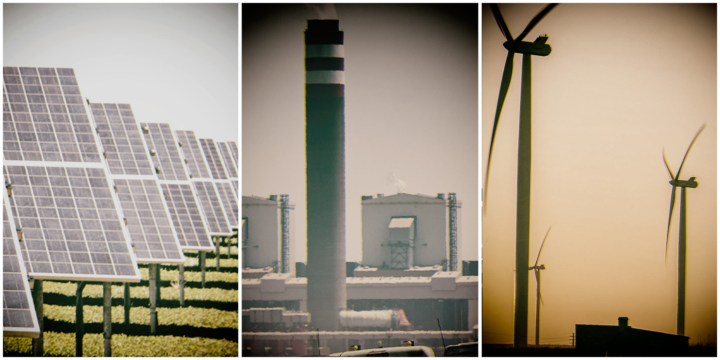ENERGY TRANSITION
Investing in a green transition could be cheaper in the long term than maintaining Eskom

A Just Transition and Climate Pathways study by the National Business Initiative, in partnership with Business Unity South Africa and Boston Consulting Group, shows that South Africa will be among the countries at greatest physical risk from climate change. This is because it is already a semi-arid country, and a global average temperature increase of 1.5°C above pre-industrial levels translates to an average 3°C increase for southern Africa.
A country that ranks in the top 20 most carbon-intensive global economies on an emissions-per-Gross Domestic Product (GDP) basis also faces a serious trade risk, and is likely to face mounting pressure as trade partners implement their low-carbon commitments.
The report further states that an investment in the green transition may be cheaper than the status quo, in the long run. For example, in SA’s power sector, about R120-billion is currently spent on primary energy costs — mostly in coal procurement — which is greater than the R100-billion annualised spend needed in capital expenditure by 2050 to transition the entire power sector to a renewable-dominated, net-zero system.
“The Eskom-As-Is scenario is a conservative view on the costs of continuing with the current energy mix. It scales capital expenditure (capex) and operating expenditure (opex) based on projected kWh growth, but does not include a growth in fuel price or a bump in capex when several coal plants reach end-of-life in the 2030s… While the challenge facing South Africa is complex, the transition is both technically feasible and commercially viable,” the report states.
Dominic Goncalves, a senior associate specialising in decarbonisation solutions at the Cresco Group, says there are two realistic scenarios for South Africa: chronic, persistent rolling blackouts for at least the next five years, or a total national power system collapse.
“Climate change, the energy transition, supply chain issues, materials shortages and the war in Ukraine all mean that load shedding is now a global issue being experienced in First World countries too,” he says, offering the following examples:
- California experiences wildfires each year, causing blackouts that routinely knock out the power grid for up to seven days. In Texas last year, more than five million Americans were left without power for several days, as climate volatility caused rolling blackouts.
- In Spain and Portugal earlier this year, a weather phenomenon called the calima, a giant dust storm, caused winds to carry so much sand from the Sahara that it blanketed much of southern Europe with reddish sand. About a third of Spain’s electricity is generated from solar panels, some of which were either covered with sand or damaged — resulting in lost power in some provinces for three days.
- In 2021, Germany, which is quite reliant on wind, went through a heavily cloudy and non-windy period called the Dunkelflaute — a phenomenon where little to no energy can be generated using renewable energy.
- France’s nuclear fleet — proudly lauded for years as one of the most stable power systems in the world — is in a state of disarray, with the nuclear fleet having an Energy Availability Factor (EAF) of only 54%. This is operating worse than Koeberg.
South Africa’s own coal fleet is in dire straits, with no realistic chance of EAF recovering to anything close to what is claimed by politicians and what’s needed to prevent rolling blackouts.
On Wednesday, the EAF was 51%.
Goncalves says solar and wind can ease the situation, particularly in the daytime and late afternoon when it is often windy, but until we have batteries or green hydrogen to store this solar or wind energy for longer than four to eight hours, South Africa will continue to rely on mostly fossil fuel-based back-up power.
Goncalves believes the answer lies in micro-grids, which typically have three components: one or more electricity generators; one or more types of batteries, and an energy management system — a digital control that links it all together.
A microgrid can be connected to the grid or disconnected completely if needed.
Visit Daily Maverick’s home page for more news, analysis and investigations
“Microgrids typically use solar panels and wind turbines as the anchor technologies. Solar water heaters, heat pumps and industrial solar thermal can then provide heat and steam up to around 300°C.
“Co-generation and tri-generation can reuse waste heat gas and optimise systems. Lithium batteries, inverters, super-capacitors, fuel cells and other types of batteries can be coupled together to maximise storage when there is no sun or wind,” he says.
As far back as 2020, Goldfields built one of the world’s largest microgrids to power a gold mine in Australia. In August this year, it opened a R715-million, 50MW Khanyisa solar plant at South Deep Gold Mine in Westonaria, Gauteng.
The plant is expected to dramatically lower energy costs, saving the company about R123-million, or 24% of its electricity costs, a year. BM/OBP/DM





















 Become an Insider
Become an Insider
In discussions about renewables, the fourth pillar, biomass, is regularly forgotten, alongside wind, solar and hydro. The higher the proportion of biomass, the faster the energy transition is progressing. You don’t even have to look at Europe – a look at Namibia would be very enlightening.